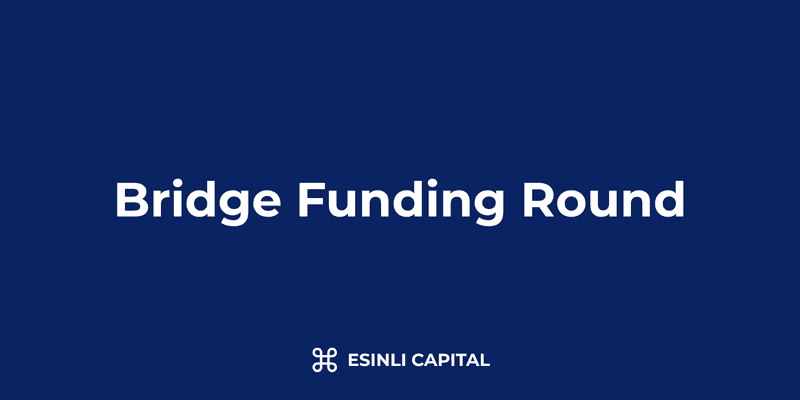In This Article
- What Is a Bridge Funding Round?
- Bridge Round Structure and Key Terms
- Existing Investors vs. New Investors
- Strategic Timing of Bridge Financing
- Bridge Funding Round: Alternatives and Considerations
- Negotiating Bridge Round Terms
- Bridge Funding Success Stories and Failures
- Bridge Funding Rounds in Different Market Conditions
- Investor Perspective on Bridge Rounds
- The Bottom Line
- What Is a Bridge Funding Round?
- Bridge Round Structure and Key Terms
- Existing Investors vs. New Investors
- Strategic Timing of Bridge Financing
- Bridge Funding Round: Alternatives and Considerations
- Negotiating Bridge Round Terms
- Bridge Funding Success Stories and Failures
- Bridge Funding Rounds in Different Market Conditions
- Investor Perspective on Bridge Rounds
- The Bottom Line

Bridge Funding Round: What It Is, When to Use It & Key Terms to Know
A bridge funding round helps startups extend their financial runway between larger fundraising events. Often structured as convertible notes or SAFEs, bridge rounds are designed to buy time—whether to reach key milestones, improve valuation, or close a delayed Series A. In this article, you’ll learn how bridge rounds work, when they make sense, the terms investors expect, and how to negotiate favorable conditions.
KEY TAKEAWAYS
- A bridge funding round is a short-term financing solution designed to extend a startup's runway until it can secure a larger, more permanent funding round.
- Bridge rounds typically use convertible notes or SAFEs with terms including discount rates (15-25%), valuation caps, and maturity dates (12-24 months).
- Bridge financing most commonly comes from existing investors, with new investors often hesitant due to perceived risks.
- Strategic timing is crucial—securing bridge funding 6-9 months before cash depletion gives founders optimal negotiating leverage.
- Alternatives to bridge rounds include revenue-based financing, venture debt, and strategic cost reductions.
What Is a Bridge Funding Round?
A bridge funding round is a type of interim financing that helps startups "bridge" the gap between major equity funding rounds. Unlike traditional equity rounds (Series A, B, C), bridge financing is typically structured as convertible debt or convertible equity (like SAFEs) that will later convert into equity when the company raises its next priced round.
Bridge rounds serve several key purposes:
- Extending runway: Providing additional cash to extend a startup's operational timeline
- Avoiding down rounds: Preventing the need to raise money at a lower valuation than previous rounds
- Buying time: Allowing the company to reach key milestones that will justify a higher valuation in the next round
- Weathering market conditions: Helping companies survive during periods of market volatility or economic downturns
When Should Startups Consider Bridge Funding?
Bridge funding becomes an appropriate financing option in several scenarios:
Between major funding rounds: If a startup needs capital after a Series A but isn't quite ready for a Series B, a bridge round can provide the necessary funds to reach the milestones that will make the company attractive for the larger round.
During challenging market conditions: When the broader fundraising environment is difficult (such as during economic downturns), bridge funding from existing investors can help companies weather the storm.
After pivot or strategic shift: If a company has changed its business model or market focus and needs time to demonstrate traction in the new direction.
When nearing profitability: For companies that are close to break-even and need additional runway to reach profitability and reduce their dependence on external funding.
While awaiting a strategic acquisition: When a startup is in discussion with potential acquirers but needs capital to maintain operations during the negotiation period.
Bridge Round Structure and Key Terms
Bridge rounds typically use one of two primary financing instruments: convertible notes or Simple Agreements for Future Equity (SAFEs). Both allow investors to provide capital that will later convert into equity at the next priced round.
Common Bridge Financing Instruments
Convertible Notes are debt instruments that convert to equity at a future financing event. Key terms include:
- Interest rate: Typically 5-8% annually
- Maturity date: Usually 12-24 months
- Discount rate: 15-25% off the next round's valuation
- Valuation cap: Maximum valuation at which the note converts
- Conversion triggers: Events that cause the note to convert (typically the next equity financing)
SAFEs (Simple Agreements for Future Equity) are similar to convertible notes but without debt components:
- No interest rate or maturity date
- Include discount rates (15-25%) and valuation caps
- Convert automatically at the next qualified financing round
- Typically simpler and faster to execute than convertible notes
Bridge Round Terms: Market Standards
A well-structured bridge round balances the needs of the company with fair terms for investors taking on additional risk. Standard terms typically include:
Valuation Caps: Range from the previous round's valuation to a 30% premium, depending on the company's progress and market conditions.
Discount Rates: Typically 15-25%, with higher discounts reflecting greater perceived risk or longer expected time to the next round.
Participation Rights: Existing investors often receive pro-rata rights to maintain their ownership percentage in future rounds.
Information Rights: Investors typically receive enhanced reporting and information rights during the bridge period.
Board Observation Rights: New major bridge investors may receive board observation rights (without voting powers).
Investor Protections: May include protective provisions, such as restricting certain major decisions without investor approval.
Existing Investors vs. New Investors
Bridge rounds most commonly involve participation from existing investors, though new investors may also participate under certain circumstances.
The Role of Existing Investors
Existing investors typically lead bridge rounds for several reasons:
- Portfolio protection: They're protecting their initial investment by giving the company more runway
- Information advantage: They have deeper knowledge about the company's operations and potential
- Signal effect: Their participation sends a positive signal to potential future investors
- Terms negotiation: They may have preferential negotiation positions due to existing relationships
Many venture capital firms set aside "reserves" specifically for follow-on and bridge investments in their portfolio companies, typically 1-2x their initial investment amount.
Attracting New Investors
While more challenging, attracting new investors to a bridge round is possible under certain conditions:
Strong growth despite cash constraints: Demonstrating that the company's core metrics are improving even as cash dwindles Strategic value-add: Offering specific strategic advantages to new investors (industry expertise, customer connections) Favorable terms: Providing better terms than existing investors (higher discounts, lower caps) to compensate for increased risk Transparency about challenges: Being forthright about challenges while presenting a clear path forward
New investors often view bridge rounds with caution, as they may indicate that existing investors lack confidence or that the company has underperformed relative to expectations.
Strategic Timing of Bridge Financing
The timing of a bridge round is critical to both its success and the terms a company can secure.
Optimal Timing Window
Too early: Raising a bridge round too early may signal poor cash management and reduce urgency among investors.
Too late: Waiting until the company is nearly out of cash severely weakens negotiating leverage and may lead to unfavorable terms or failure to close.
Ideal timing: Initiating bridge funding discussions when the company has 6-9 months of runway remaining. This demonstrates responsible planning while maintaining negotiating leverage.
Key Timing Considerations
Milestone proximity: Timing bridge funding to coincide with the achievement of key business milestones can strengthen the company's position.
Seasonal factors: For businesses with seasonal dynamics, timing bridge rounds to account for seasonal cash flow variations is important.
Market conditions: Monitoring broader fundraising environment conditions and timing bridge discussions during favorable windows can improve outcomes.
Investor cycles: Understanding the fundraising and decision cycles of key investors can help optimize timing.
Bridge Funding Round: Alternatives and Considerations
Before pursuing a bridge round, founders should consider alternative financing options and carefully weigh the implications.
Alternative Financing Options
Venture Debt: Traditional debt financing specifically designed for venture-backed companies, typically with warrants attached.
Revenue-Based Financing: Funding repaid as a percentage of future revenues, often suitable for companies with consistent revenue streams.
Grants and Non-Dilutive Funding: Government grants, R&D tax credits, or industry-specific programs that don't require equity dilution.
Strategic Partnerships: Advance payments or development funding from strategic partners or potential customers.
Accelerated Revenue Strategies: Prepayment incentives, annual contracts, or other approaches to bring cash flow forward.
Strategic Considerations for Founders
Signaling risk: Bridge rounds can signal to the market that the company is struggling, potentially affecting future fundraising efforts.
Dilution effects: Understanding how the conversion terms will affect cap table and founder ownership at the next priced round.
Term sheet provisions: Negotiating for provisions that protect the company's interests, such as optional conversion at maturity.
Cash flow management: Implementing strict cash management practices to extend runway alongside the bridge funding.
Milestone planning: Creating clear, achievable milestones that will demonstrate significant progress by the next fundraising attempt.
Negotiating Bridge Round Terms
Successful bridge round negotiations require preparation, transparency, and an understanding of both company and investor needs.
Preparation and Approach
Data readiness: Having up-to-date financial projections, key metrics, and clear milestone plans.
Market research: Understanding comparable companies' terms and current market standards for bridge financing.
Multiple options: Preparing various funding scenarios with different terms and amounts to facilitate discussions.
Communication strategy: Developing a clear narrative that explains the need for bridge funding while highlighting future potential.
Key Negotiation Points
Valuation cap: Often the most contentious point, as it effectively sets a maximum on the investors' future ownership stake.
Discount rate: Balancing fair compensation for investor risk without excessive dilution.
Pro-rata rights: Determining whether existing investors maintain rights to invest in future rounds.
Board seats or observation rights: Managing governance implications of the bridge round.
Maturity provisions: Negotiating favorable terms for what happens if the next round doesn't occur before maturity.
Bridge Funding Success Stories and Failures
Learning from real-world examples can provide valuable insights into effective bridge funding strategies.
Success Case: Airbnb's Bridge to Success
During the 2008 financial crisis, Airbnb struggled to raise its Series A round. Existing investors provided a bridge round that allowed the company to survive the downturn and refine its business model. This bridge financing helped the company reach profitability in 2016 and eventually go public with a $100+ billion valuation in 2020.
Failure Case: The Danger of Bridge Dependency
A well-known food delivery startup raised multiple bridge rounds between 2018-2020, each with increasingly onerous terms. By the time the company attempted to raise a proper Series C, the cap table had become so complicated and founder ownership so diluted that new investors were unwilling to participate. The company eventually sold in a distressed acquisition.
Key Lessons
Single bridge rule: Successful companies typically raise only one bridge round before securing a larger equity round.
Clear milestone focus: The most effective bridge rounds fund specific, achievable milestones that will meaningfully change the company's valuation.
Investor alignment: Companies with strong alignment between founder and investor interests navigate bridge rounds more successfully.
Transparent communication: Maintaining open communication with investors about challenges and progress reduces friction during bridge negotiations.
Bridge Funding Rounds in Different Market Conditions
The structure, terms, and availability of bridge funding vary significantly based on broader market conditions.
Bull Market Dynamics
During favorable funding environments:
- Bridge rounds may include new investors seeking entry points into promising companies
- Terms tend to be more founder-friendly
- Discount rates trend toward the lower end (10-15%)
- Bridge rounds may be raised opportunistically rather than out of necessity
Bear Market Realities
During challenging funding environments:
- Bridge rounds primarily come from existing investors
- Terms become more investor-friendly
- Higher discount rates (20-30%) and lower valuation caps
- May include additional protective provisions and governance changes
- Often focused on extending runway until market conditions improve
Economic Downturn Strategies
During broader economic downturns:
- Bridge funding may be paired with significant cost-cutting measures
- Focus shifts to near-term profitability rather than growth
- Investors typically require more detailed milestone planning
- Multiple tranches with milestone-based release may become more common
Investor Perspective on Bridge Rounds
Understanding how investors view bridge rounds can help founders prepare more effectively.
Existing Investor Considerations
When deciding whether to participate in a bridge round, existing investors typically evaluate:
Portfolio allocation: Whether additional investment aligns with their fund's portfolio strategy and reserve allocations.
Progress since last round: Whether the company has made sufficient progress to justify additional investment.
Team assessment: Whether the management team has demonstrated adaptability and execution capacity.
Market evolution: Whether market conditions or competitive landscape have changed significantly.
Syndicate dynamics: Whether other key investors are participating in the bridge.
New Investor Considerations
New investors evaluating participation in a bridge round typically focus on:
Bridge rationale: Understanding why a bridge is necessary rather than a priced round.
Existing investor participation: Assessing whether major existing investors are participating proportionally.
Term favorability: Evaluating whether the offered terms adequately compensate for the perceived risk.
Path to next round: Assessing the clarity and credibility of the path to the next priced round.
Cap table complexity: Evaluating whether the cap table structure remains clean enough to accommodate future rounds.
The Bottom Line
Bridge funding rounds serve as crucial financing tools for startups navigating the gap between major equity rounds or during challenging market conditions. When structured appropriately and timed strategically, they can provide the runway necessary for companies to reach important milestones, avoid down rounds, and position themselves for long-term success.
The most successful bridge rounds share common characteristics: they involve meaningful participation from existing investors, include clear and achievable milestone planning, maintain reasonable valuation expectations, and provide sufficient runway to reach the next significant funding event.
For founders, the key to successful bridge financing lies in proactive planning, transparent communication, and disciplined execution. By approaching bridge rounds as strategic opportunities rather than last-resort options, startups can use them effectively to navigate challenging periods and emerge in stronger positions.
For investors, bridge rounds represent opportunities to protect and potentially enhance the value of existing investments, though they require careful evaluation of company progress, market conditions, and management capabilities.
In the dynamic world of startup financing, bridge rounds remain an important tool in the funding toolkit—one that, when used judiciously, can help promising companies cross challenging waters and reach their full potential.


